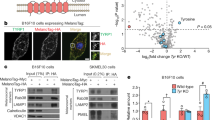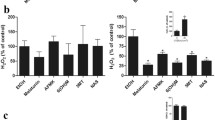Abstract
Recent evidence suggests that the melanogenesis intermediate 5-S-cysteinyldopa (5-S-CD) could display antioxidative activity. In the present study, the synthesis of 5-S-CD was examined in human epidermal melanocytes isolated from dark skin type VI (MT) and from white skin type III (GT). The MT melanocytes showed the higher melanin content and dopa oxidase activity. In addition, they produced eumelanin as shown by their ultrastructure, and the solubility and UV/visible absorption of the isolated pigment. Both MT and GT cells showed high levels of 5-S-CD (5.5–6.9 nmol/mg protein). 5-S-CD was also detected in culture supernatants from MT cells; the secretion rate was estimated to be 2.5 nmol/mg protein per 24 h. The role of cysteine and glutathione in 5-S-CD formation was investigated by exposing the melanocytes to theγ-glutamylcysteine synthetase inhibitorl-buthionine sulfoximine (BSO). A strong reduction in glutathione levels (4–8% of the untreated controls) associated with an increase in cysteine levels (152–154%) was observed. In addition, BSO induced a moderate increase in the cellular levels of 5-S-CD (114–129%) and a decrease in dopa oxidase activity (75–83%). Our results indicate that the direct addition of cysteine to dopaquinone is the main source of 5-S-CD in human epidermal melanocytes. It is proposed that the synthesis of 5-S-CD is a mechanism regulating dopaquinone levels during pigment formation and/or a defence mechanism against oxidative stress.
Similar content being viewed by others
References
Agrup G, Falck B, Kennedy B-M, Rorsman H, Rosengren A-M, Rosengren E (1975) Formation of cysteinyldopa from glutathionedopa in melanoma. Acta Derm Venereol (Stockh) 55: 1–3
Ando H, Oka M, Ichihashi M, Mishima Y (1990) Protein kinase C and linoleic acid-induced inhibition of melanogenesis. Pigment Cell Res 3: 200–206
Barrandon Y, Li V, Green H (1988) New techniques for the grafting of cultured human epidermal cells onto athymic animals. J Invest Dermatol 91: 315–318
Benathan M, Alvero-Jackson H, Mooy A-M, Scaletta C, Frenk E (1992) Relationship between melanogenesis, glutathione levels and melphalan toxicity in human melanoma cells. Melanoma Res 2: 305–314
Benathan M, Scaletta C, Frenk E (1994) Demonstration of tyrosinase-dependent and tyrosinase-independent 5-S-cysteinyldopa genesis in vitro. Melanoma Res 4[Suppl 2]: 14
Bustamante J, Bredeston L, Malanga G, Mordoh J (1993) Role of melanin as a scavenger of active oxygen species. Pigment Cell Res 6: 348–353
Carstam R, Hansson C, Lindbladh, Rorsman H, Rosengren E (1987) Dopaquinone addition products in cultured human melanoma cells. Acta Derm Venereol (Stockh) 67: 100–105
Connor M, Wheeler L (1987) Depletion of cutaneous glutathione by ultraviolet radiation. Photochem Photobiol 46: 239–245
Eisinger M, Marko O (1982) Selective proliferation of normal human melanocytes in vitro in the presence of phorbol ester and cholera toxin. Proc Natl Acad Sci USA 79: 2018–2022
Griffith OW, Meister A (1979) Potent and specific inhibition of glutathione synthesis by buthionine sulfoximine (S-n-butyl homocysteine sulfoximine). J Biol Chem 254: 7558–7560
Hatta S, Mishima Y, Ichihashi M, Ito S (1988) Melanin monomers within coated vesicles and premelanosomes in melanin synthesizing cells. J Invest Dermatol 91: 181–184
Iizawa O, Kato T, Tagami H, Akamatsu H, Niwa Y (1994) Longterm follow-up study of changes in lipid peroxide levels and the activity of superoxide dismutase, catalase and glutathione peroxidase in mouse skin after acute and chronic UV irradiation. Arch Dermatol Res 286: 47–52
Ito S (1989) Optimization of conditions for preparing synthetic pheomelanin. Pigment Cell Res 2: 53–56
Ito S, Kato T, Maruta K, Fujita K (1984) Determination of DOPA, dopamine, and 5-S-cysteinyl-DOPA in plasma, urine, and tissue samples by high-performance liquid chromatography with electrochemical detection. J Chromatogr 311: 154–159
Jergil B, Lindbladh CH, Rorsman H, Rosengren E (1984) Inactivation of human tyrosinase by cysteine. Protection by dopa and tyrosine. Acta Derm Venereol (Stockh) 64: 155–182
Kågedal B, Gawelin A-L, Pettersson A (1987) Synthesis of 5-S-L-cysteinyl-glycine-L-dopa, a natural substrate for serum and melanocyte dipeptidase. Anal Biochem 165: 167–174
Karg E, Odh G, Rosengren E, Wittbjer A, Rorsman H (1991a) Melanin-related biochemistry of IGR 1 human melanoma cells. Melanoma Res 1: 5–13
Karg E, rosengren E, Rorsman H (1991b) Hydrogen peroxide as a mediator of dopac-induced effects on melanoma cells. J Invest Dermatol 96: 224–227
Kato Y, Nishikawa T, Kawakishi S (1995) Formation of protein-bound 3,4-dihydroxyphenylalanine in collagen types I and IV exposed to ultraviolet light. Photochem Photobiol 61: 367–372
Kobayashi T, Urabe K, Winder A, Jiménez-Cervantes C, Imokawa G, Brewington T, Solano F, Garcia-Borron J-C, Hearing V (1994) Tyrosinase related protein 1 (TRP1) functions as a DHICA oxidase in melanin biosynthesis. EMBO J 13: 5818–5825
Lowry OH, Rosebrough NJ, Farr AL, Randall RS (1951) Protein measurements with the Folin phenol reagent. J Biol Chem 193: 265–275
Marmol V del, Ito S, Jackson I, Vachtenheim J, Berr P, Ghanem G, Morandini R, Wakamatsu K, Huez G (1993) TRP-1 expression correlates with eumelanogenesis in human pigment cells in culture. FEBS Lett 327: 307–310
Mojamdar M, Ichihashi M, Mishima Y (1983)γ-Glutamyl transpeptidase, tyrosinase, and 5-S-cysteinylgopa production in melanoma cells. J Invest Dermatol 81: 119–121
Napolitano A, Palumbo A, Misuraca G, Prota G (1993) Inhibitory effect of melanin precursors on arachidonic acid peroxidation. Biochim Biophys Acta 1168: 175–180
Pavel S (1993) Regulatory mechanisms of melanogenesis: beyond the tyrosinase concept. J Invest Dermatol 100: 156S-161S
Rorsman H, Albertsson E, Edholm L-E, Hansson C, Ogren L, Rosengren E. (1988) Thiols in the melanocyte. Pigment Cell Res [Suppl] 1: 54–60
Schallreuter K, Wood J, Lemke R, LePoole C, Das P, Westerhof W, Pittelkow M, Thody A (1992) Production of catecholamines in the human epidermis. Biochim Biophys Res Commun 189: 72–78
Schmitz S, Thomas P, Allen T, Poznansky M, Jimbow K (1995) Dual role of melanins and melanin precursors as photoprotective and phototoxic agents: inhibition of ultraviolet radiation-induced lipid peroxidation. Photochem Photobiol 61: 650–655
Shindo Y, Witt E, Packer L (1993) Antioxidant defense mechanisms in murine epidermis and dermis and their responses to ultraviolet light. J Invest Dermatol 100: 260–265
Sichel G, Corsaro C, Scalia M, Di Bilio A, Bonomo R (1991) In vitro scavenger activity of some flavonoids and melanins against O2 −. Free Radic Biol Med 11: 1–8
Simpson J, Gieseg S, Dean R (1993) Free radical and enzymatic mechanisms for the generation of protein bound reducing moieties. Biochim Biophys Acta 1156: 190–196
Stein AF, Dills RL and Klaassen CD (1986) High-performance liquid chromatographic analysis of glutathione and its thiol and disulfide degradation products. J Chromatogr 381: 259–270
Tyrrell R, Pidoux M (1988) Correlation between endogenous glutathione content and sensitivity of cultured human skin cells to radiation at defined wavelengths in the solar ultraviolet range. Photochem Photobiol 47: 405–412
Winder A, Wittbjer A, Rosengren E, Rorsman H (1993) Fibroblasts expressing mouse c locus tyrosinase produce an authentic enzyme and synthesize phaeomelanin. J Cell Sci 104(2): 467–475
Author information
Authors and Affiliations
Rights and permissions
About this article
Cite this article
Benathan, M., Labidi, F. Cysteine-dependent 5-S-cysteinyldopa formation and its regulation by glutathione in normal epidermal melanocytes. Arch Dermatol Res 288, 697–702 (1996). https://doi.org/10.1007/BF02505280
Received:
Issue Date:
DOI: https://doi.org/10.1007/BF02505280




